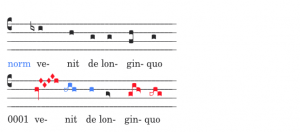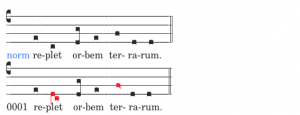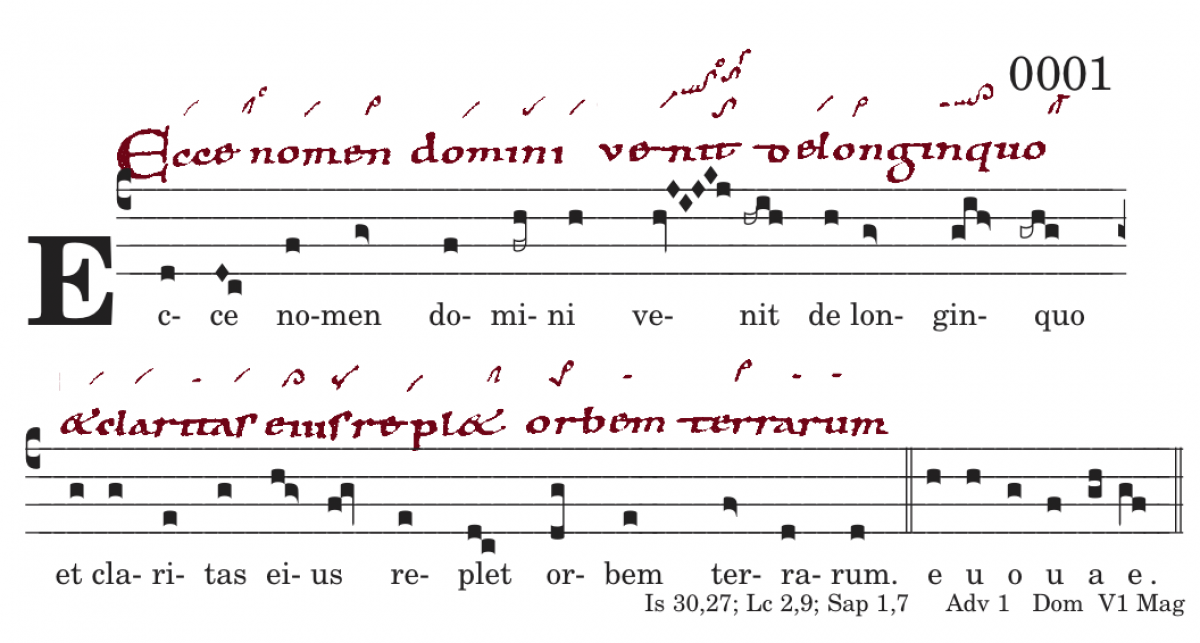Benutzer-Werkzeuge
🔘 IN GR TR AL OF CO xxxxx ✅ 2️⃣ 0️⃣ 3️⃣ 4️⃣ 5️⃣ 6️⃣ 7️⃣ 8️⃣ xxxxx AN RP IV alia
0001 AN Ecce nomen domini venitModus 1
↖️
Der aus drei Bibelstellen kompilierte Text (Is 30,27; Lc 2,9; Sap 1,7) eröffnet das ganze Kirchenjahr. Dieser Position entsprechend ist der Text in klassischer Vierteiligkeit und dem 1TYPOS zugeteilt:

1INC Clv Incipit cum clive, Dieser Cento führt vom re zum la, die Hauptaussage der Antiphon folgt unmittelbar darauf: „vénit“. Das INC Clv eröffnet die meisten Antiphonen des Protus authenticus (PR1). Der augmentative Cephalicus auf „no-men“ rundet einerseits das Wort „nomen“ im nachhinein ab und macht es daher etwas wichtiger, andererseits staut er vor dem nächsten Wort „dómini“ und verstärkt auch dieses.
1MED typ Die Mediatio, das Ende des ersten Halbverses, trägt die Sinnspitze der Antiphon „vénit“, üblicherweise auf „sa“, und führt zur Mittelkadenz auf „sol“ (Mediatio, Asteriscus). In dieser Antiphon setzt der „Komponist“ alles ein, was gut und teuer ist. Entgegen der Normalform steigt die Sinnspitze zum do und begrüßt den, der da kommt mit
circulatio (im 1.Modus durchaus als applicatio = Zuwendung zu verstehen). Die Endsilbe des Schlüsselwortes „ve-nit“ wird mit dem Torculus der Wortartikulation TrcFIN abgerundet. „de longinquo“ „von weither“ wird ebenfalls aufgewertet:
TorCl - cf. 2002
1NOV typ Neuanfang (Reintonatio) führt vom „sol“ zum „fa“. Die Reintonatio ist schlicht, nur der augmentative Cephalicus „é-ius“ gibt dem Wort mehr Gewicht. Der
~Pes (Pes quassus) am Ende des Cento führt von seinem eigentlichen Zielton „fa“ weg, das verhindert eine beruhigende, abschließende Wirkung und führt weiter, colon (Doppelpunkt).
1TER penult endet auf der Finalis „re“. Die TER penult, die Finalformel für Texte mit Betonung auf dem vorletzten Akzent, ist hier richtig: „replet órbem terrarum“ = „erfüllt die gánze Welt“. Die Clivis auf „re-plet“ beschleunigt den Text auf den Akzent hin, der Cephalicus auf „ter-rarum“ lässt den letzten Akzent nicht ganz neben dem Hauptakzent auf der vorletzen Silbe untergehen.
● Siehe der Name des Herrn kommt von weither, und seine Herrlichkeit erfüllt den Erdkreis.
● Behold, the name of the Lord comes from afar, and his glory fills the earth.
The text compiled from three biblical passages (Is 30:27; Lc 2:9; Sap 1:7) opens the entire church year. In accordance with this position, the text is in the classical quadripartite order and assigned to 1TYPOS:

1INC Clv Incipit cum clive, This cento leads from re to la, the main statement of the antiphon follows immediately: „vénit“. The INC clv opens most of the antiphons of the Protus authenticus (PR1). The augmentative cephalicus on „no-men“ rounds off the word „nomen“ afterwards and therefore makes it somewhat more important, on the other hand it builds up before the next word „dómini“ and also reinforces it.
1MED typ The mediatio, the end of the first half-verse, carries the meaning of the antiphon „vénit“, usually on „sa“, and leads to the middle cadence on „sol“ (mediatio, asteriscus). In this antiphon, the „composer“ uses everything that is good and expensive. Contrary to the normal form, the tip of the meaning rises to the do and welcomes the one who is coming with
circulatio (in the 1st mode this can certainly be understood as applicatio = affection). The final syllable of the key word „ve-nit“ is rounded off with the torculus of the word articulation TrcFIN. „de longinquo“ „from afar“ is also upgraded:
TorCl - cf. 2002
1NOV typ New beginning (reintonatio) leads from „sol“ to „fa“. Reintonatio is simple, only the augmentative cephalicus „é-ius“ gives the word more weight. The
~Pes (pes quassus) at the end of the cento leads away from its actual target tone „fa“, which prevents a calming, concluding effect and leads on, colon (colon).
1TER penult ends on the finalis „re“. The TER penult, the final formula for texts with emphasis on the penultimate accent, is correct here: „replet órbem terrarum“ = „fulfils the gánze world“. The clivis on „re-plet“ accelerates the text towards the accent, the cephalicus on „ter-rarum“ does not allow the last accent to disappear completely next to the main accent on the penultimate syllable.


